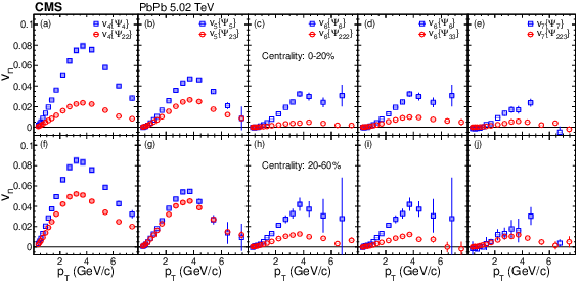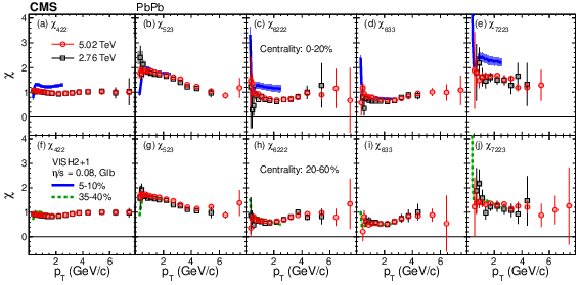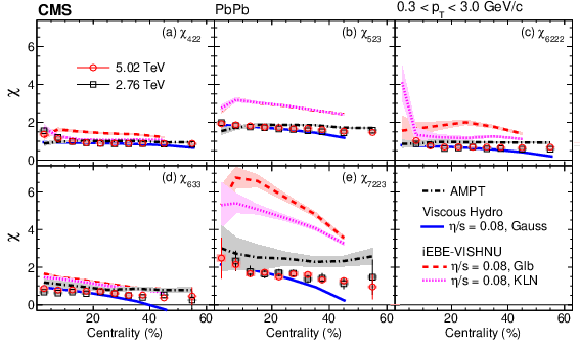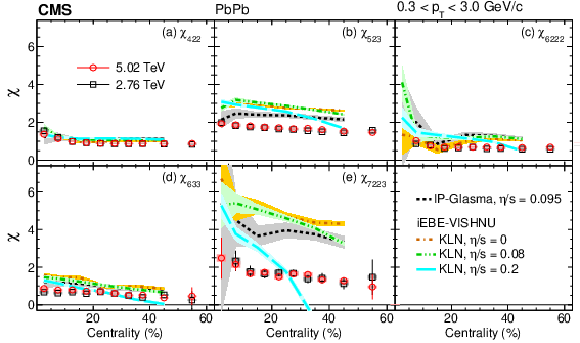

Compact Muon Solenoid
LHC, CERN
| CMS-HIN-17-005 ; CERN-EP-2019-211 | ||
| Mixed higher-order anisotropic flow and nonlinear response coefficients of charged particles in PbPb collisions at ${\sqrt {\smash [b]{s_{_{\mathrm {NN}}}}}} = $ 2.76 and 5.02 TeV | ||
| CMS Collaboration | ||
| 19 October 2019 | ||
| Eur. Phys. J. C 80 (2020) 534 | ||
| Abstract: Anisotropies in the initial energy density distribution of the quark-gluon plasma created in high energy heavy ion collisions lead to anisotropies in the azimuthal distributions of the final-state particles known as collective flow. Fourier harmonic decomposition is used to quantify these anisotropies. The higher-order harmonics can be induced by the same order anisotropies (linear response) or by the combined influence of several lower order anisotropies (nonlinear response) in the initial state. The mixed higher-order anisotropic flow and nonlinear response coefficients of charged particles are measured as functions of transverse momentum and centrality in PbPb collisions at nucleon-nucleon center-of-mass energies ${\sqrt {\smash [b]{s_{_{\mathrm {NN}}}}}} = $ 2.76 and 5.02 TeV with the CMS detector. The results are compared with viscous hydrodynamic calculations using several different initial conditions, as well as microscopic transport model calculations. None of the models provides a simultaneous description of the mixed higher-order flow harmonics and nonlinear response coefficients. | ||
| Links: e-print arXiv:1910.08789 [hep-ex] (PDF) ; CDS record ; inSPIRE record ; HepData record ; CADI line (restricted) ; | ||
| Figures | |

png pdf |
Figure 1:
Mixed higher-order flow harmonics, $v_4\{\Psi _{22}\}$, $v_5\{\Psi _{23}\}$, $v_6\{\Psi _{222}\}$, $v_6\{\Psi _{33}\}$, and $v_7\{\Psi _{223}\}$ from the scalar-product method at $ {\sqrt {\smash [b]{s_{_{\mathrm {NN}}}}}} = $ 2.76 and 5.02 TeV as a function of ${p_{\mathrm{T}}}$ in the 0-20% (upper row) and 20-60% (lower row) centrality ranges. Statistical (bars) and systematic (shaded boxes) uncertainties are shown. |

png pdf |
Figure 2:
Comparison of mixed higher-order flow harmonics, $v_4\{\Psi _{22}\}$, $v_5\{\Psi _{23}\}$, $v_6\{\Psi _{222}\}$, $v_6\{\Psi _{33}\}$ and $v_7\{\Psi _{223}\}$ with the corresponding overall flow, $v_4\{\Psi _{4}\}$, $v_5\{\Psi _{5}\}$, $v_6\{\Psi _{6}\}$, $v_6\{\Psi _{6}\}$ and $v_7\{\Psi _{7}\}$, respectively, at $ {\sqrt {\smash [b]{s_{_{\mathrm {NN}}}}}} = $ 5.02 TeV as a function ${p_{\mathrm{T}}}$ in the 0-20% (upper row) and 20-60% (lower row) centrality ranges. Statistical (bars) and systematic (shaded boxes) uncertainties are shown. |

png pdf |
Figure 3:
Nonlinear response coefficients, $\chi _{422}$, $\chi _{523}$, $\chi _{6222}$, $\chi _{633}$, and $\chi _{7223}$ from the scalar-product method at $ {\sqrt {\smash [b]{s_{_{\mathrm {NN}}}}}} = $ 2.76 and 5.02 TeV as a function of ${p_{\mathrm{T}}}$ in the 0-20% (upper row) and 20-60% (lower row) centrality ranges. Statistical (bars) and systematic (shaded boxes) uncertainties are shown. The results are compared with hydrodynamic predictions [24] at $ {\sqrt {\smash [b]{s_{_{\mathrm {NN}}}}}} = $ 2.76 TeV with $\eta /s = $ 0.08 and Glauber initial conditions in the 5-10% (blue lines) and 35-40% (dashed green lines) centrality ranges. |

png pdf |
Figure 4:
Mixed higher-order flow harmonics, $v_4\{\Psi _{22}\}$, $v_5\{\Psi _{23}\}$, $v_6\{\Psi _{222}\}$, $v_6\{\Psi _{33}\}$, and $v_7\{\Psi _{223}\}$ from the scalar-product method at $ {\sqrt {\smash [b]{s_{_{\mathrm {NN}}}}}} = $ 2.76 and 5.02 TeV, as a function of centrality. Statistical (bars) and systematic (shaded boxes) uncertainties are shown. Hydrodynamic predictions [21] with $\eta /s = $ 0.08 (blue lines) at 2.76 TeV are shown in panel (b) and (e). |

png pdf |
Figure 5:
Nonlinear response coefficients, $\chi _{422}$, $\chi _{523}$, $\chi _{6222}$, $\chi _{633}$, and $\chi _{7223}$ from the scalar-product method at $ {\sqrt {\smash [b]{s_{_{\mathrm {NN}}}}}} = $ 2.76 and 5.02 TeV, as a function of centrality. Statistical (bars) and systematic (shaded boxes) uncertainties are shown. The results are compared with predictions at $ {\sqrt {\smash [b]{s_{_{\mathrm {NN}}}}}} = $ 2.76 TeV from AMPT [42] as well as hydrodynamics with a deformed symmetric Gaussian density profile as the initial conditions using $\eta /s = $ 0.08 from Ref. [21], and from iEBE-VISHNU hydrodynamics with both Glauber and the KLN initial conditions using the same $\eta /s$ [22]. |

png pdf |
Figure 6:
The same results as in Fig. 5 but compared with predictions from a hydrodynamics $+$ hadronic cascade hybrid approach with the IP-Glasma initial conditions using $\eta /s = 0.095$ [44] at $ {\sqrt {\smash [b]{s_{_{\mathrm {NN}}}}}} = $ 5.02 TeV and from iEBE-VISHNU hydrodynamics with the KLN initial conditions using $\eta /s = $ 0, 0.08 (the same curve as in Fig. 5) and 0.2 [22] at $ {\sqrt {\smash [b]{s_{_{\mathrm {NN}}}}}} = $ 2.76 TeV. |
| Summary |
| The mixed higher-order flow harmonics and nonlinear response coefficients of charged particles have been studied as functions of transverse momentum ${p_{\mathrm{T}}}$ and centrality inPbPbcollisions at ${\sqrt {\smash [b]{s_{_{\mathrm {NN}}}}}} = $ 2.76 and 5.02 TeV using the CMS detector. The measurements use the scalar-product method, covering a ${p_{\mathrm{T}}}$ range from 0.3 to 8.0 GeV/$c$, pseudorapidity $ |{\eta}| < $ 0.8, and a centrality range of 0-60%. The mixed higher-order flow harmonics, $v_4\{\Psi_{22}\}$, $v_5\{\Psi_{23}\}$, $v_6\{\Psi_{222}\}$, $v_6\{\Psi_{33}\}$, and $v_7\{\Psi_{223}\}$ all have a qualitatively similar ${p_{\mathrm{T}}}$ dependence, first increasing at low ${p_{\mathrm{T}}}$, reaching a maximum at about 3-4 GeV/$c$, and then decreasing at higher ${p_{\mathrm{T}}}$. As a comparison, the overall $v_n$ harmonics ($n = 4$-7) with respect to their own symmetry planes are measured in the same ${p_{\mathrm{T}}}$, $\eta$, and centrality ranges. The relative contribution of the nonlinear part for $v_5$ is larger than for other harmonics in the centrality range 20-60%. In addition, the nonlinear response coefficients of the odd harmonics are observed to be larger than those of even harmonics for ${p_{\mathrm{T}}}$ less than 3 GeV/$c$. At ${p_{\mathrm{T}}}$ less than 1 GeV/$c$, a viscous hydrodynamic calculation with Glauber initial conditions and shear viscosity to entropy density ratio $\eta/s = $ 0.08 predicts a much stronger ${p_{\mathrm{T}}}$ dependence for the nonlinear response coefficients. The coefficients, including the first-time measurement of $\chi_{7223}$, as a function of centrality, are compared with AMPT and hydrodynamic predictions using different $\eta/s$ and initial conditions. Compared to the data, none of the models provides a simultaneous description of the mixed higher-order flow harmonics and nonlinear response coefficients. Therefore, these results can constrain both initial conditions and transport properties of the produced medium. |
| References | ||||
| 1 | PHENIX Collaboration | Formation of dense partonic matter in relativistic nucleus-nucleus collisions at RHIC: Experimental evaluation by the PHENIX collaboration | NP A 757 (2005) 184 | nucl-ex/0410003 |
| 2 | STAR Collaboration | Experimental and theoretical challenges in the search for the quark gluon plasma: The STAR collaboration's critical assessment of the evidence from RHIC collisions | NP A 757 (2005) 102 | nucl-ex/0501009 |
| 3 | PHOBOS Collaboration | The PHOBOS perspective on discoveries at RHIC | NP A 757 (2005) 28 | nucl-ex/0410022 |
| 4 | BRAHMS Collaboration | Quark gluon plasma and color glass condensate at RHIC? The perspective from the BRAHMS experiment | NP A 757 (2005) 1 | nucl-ex/0410020 |
| 5 | CMS Collaboration | Measurement of the elliptic anisotropy of charged particles produced in PbPb collisions at $ {\sqrt {\smash [b]{s_{_{\mathrm {NN}}}}}} = $ 2.76 TeV | PRC 87 (2013) 014902 | CMS-HIN-10-002 1204.1409 |
| 6 | ALICE Collaboration | Elliptic flow of charged particles in Pb-Pb collisions at 2.76 TeV | PRL 105 (2010) 252302 | 1011.3914 |
| 7 | ATLAS Collaboration | Measurement of the pseudorapidity and transverse momentum dependence of the elliptic flow of charged particles in lead-lead collisions at $ {\sqrt {\smash [b]{s_{_{\mathrm {NN}}}}}} = $ 2.76 TeV with the ATLAS detector | PLB 707 (2012) 330 | 1108.6018 |
| 8 | B. Alver and G. Roland | Collision geometry fluctuations and triangular flow in heavy-ion collisions | PRC 81 (2010) 054905 | 1003.0194 |
| 9 | CMS Collaboration | Measurement of higher-order harmonic azimuthal anisotropy in PbPb collisions at $ {\sqrt {\smash [b]{s_{_{\mathrm {NN}}}}}} = $ 2.76 TeV | PRC 89 (2014) 044906 | CMS-HIN-11-005 1310.8651 |
| 10 | B. Alver et al. | Importance of correlations and fluctuations on the initial source eccentricity in high-energy nucleus-nucleus collisions | PRC 77 (2008) 014906 | 0711.3724 |
| 11 | STAR Collaboration | Elliptic flow fluctuations in Au+Au collisions at $ {\sqrt {\smash [b]{s_{_{\mathrm {NN}}}}}} = $ 200 GeV | JPG 35 (2008) 104102 | 0808.0356 |
| 12 | PHOBOS Collaboration | Non-flow correlations and elliptic flow fluctuations in gold-gold collisions at $ {\sqrt {\smash [b]{s_{_{\mathrm {NN}}}}}} = $ 200 GeV | PRC 81 (2010) 034915 | 1002.0534 |
| 13 | J.-Y. Ollitrault, A. M. Poskanzer, and S. A. Voloshin | Effect of flow fluctuations and nonflow on elliptic flow methods | PRC 80 (2009) 014904 | 0904.2315 |
| 14 | Z. Qiu and U. W. Heinz | Event-by-event shape and flow fluctuations of relativistic heavy-ion collision fireballs | PRC 84 (2011) 024911 | 1104.0650 |
| 15 | PHENIX Collaboration | Measurements of higher-order flow harmonics in Au+Au collisions at $ {\sqrt {\smash [b]{s_{_{\mathrm {NN}}}}}} = $ 200 GeV | PRL 107 (2011) 252301 | 1105.3928 |
| 16 | ATLAS Collaboration | Measurement of event-plane correlations in $ {\sqrt {\smash [b]{s_{_{\mathrm {NN}}}}}} = $ 2.76 TeV lead-lead collisions with the ATLAS detector | PRC 90 (2014) 024905 | 1403.0489 |
| 17 | ATLAS Collaboration | Measurement of the correlation between flow harmonics of different order in lead-lead collisions at $ {\sqrt {\smash [b]{s_{_{\mathrm {NN}}}}}} = $ 2.76 TeV with the ATLAS detector | PRC 92 (2015) 034903 | 1504.01289 |
| 18 | U. Heinz, Z. Qiu, and C. Shen | Fluctuating flow angles and anisotropic flow measurements | PRC 87 (2013) 034913 | 1302.3535 |
| 19 | CMS Collaboration | Evidence for transverse momentum and pseudorapidity dependent event plane fluctuations in PbPb and pPb collisions | PRC 92 (2015) 034911 | CMS-HIN-14-012 1503.01692 |
| 20 | W. Busza, K. Rajagopal, and W. van der Schee | Heavy ion collisions: The big picture, and the big questions | Ann. Rev. Nucl. Part. Sci. 68 (2018) 339 | 1802.04801 |
| 21 | L. Yan and J.-Y. Ollitrault | $ \nu_4, \nu_5, \nu_6, \nu_7 $: nonlinear hydrodynamic response versus LHC data | PLB 744 (2015) 82 | 1502.02502 |
| 22 | J. Qian, U. W. Heinz, and J. Liu | Mode-coupling effects in anisotropic flow in heavy-ion collisions | PRC 93 (2016) 064901 | 1602.02813 |
| 23 | D. Teaney and L. Yan | Non linearities in the harmonic spectrum of heavy ion collisions with ideal and viscous hydrodynamics | PRC 86 (2012) 044908 | 1206.1905 |
| 24 | J. Qian, U. Heinz, R. He, and L. Huo | Differential flow correlations in relativistic heavy-ion collisions | PRC 95 (2017) 054908 | 1703.04077 |
| 25 | G. Giacalone, L. Yan, and J.-Y. Ollitrault | Nonlinear coupling of flow harmonics: Hexagonal flow and beyond | PRC 97 (2018) 054905 | 1803.00253 |
| 26 | W. Zhao, H.-j. Xu, and H. Song | Collective flow in 2.76 A TeV and 5.02 A TeV Pb+Pb collisions | EPJC 77 (2017) 645 | 1703.10792 |
| 27 | STAR Collaboration | Azimuthal anisotropy at RHIC: The first and fourth harmonics | PRL 92 (2004) 062301 | nucl-ex/0310029 |
| 28 | A. M. Poskanzer and S. A. Voloshin | Methods for analyzing anisotropic flow in relativistic nuclear collisions | PRC 58 (1998) 1671 | nucl-ex/9805001 |
| 29 | M. Luzum and J.-Y. Ollitrault | Eliminating experimental bias in anisotropic-flow measurements of high-energy nuclear collisions | PRC 87 (2013) 044907 | 1209.2323 |
| 30 | STAR Collaboration | Elliptic flow from two and four particle correlations in Au+Au collisions at $ {\sqrt {\smash [b]{s_{_{\mathrm {NN}}}}}} = $ 130 GeV | PRC 66 (2002) 034904 | nucl-ex/0206001 |
| 31 | CMS Collaboration | Description and performance of track and primary-vertex reconstruction with the CMS tracker | JINST 9 (2014) P10009 | CMS-TRK-11-001 1405.6569 |
| 32 | CMS Collaboration | The CMS experiment at the CERN LHC | JINST 3 (2008) S08004 | CMS-00-001 |
| 33 | GEANT4 Collaboration | GEANT4--a simulation toolkit | NIMA 506 (2003) 250 | |
| 34 | CMS Collaboration | The CMS trigger system | JINST 12 (2017) P01020 | CMS-TRG-12-001 1609.02366 |
| 35 | CMS Collaboration | Charged-particle nuclear modification factors in PbPb and pPb collisions at $ {\sqrt {\smash [b]{s_{_{\mathrm {NN}}}}}} = $ 5.02 TeV | JHEP 04 (2017) 039 | CMS-HIN-15-015 1611.01664 |
| 36 | I. P. Lokhtin and A. M. Snigirev | A model of jet quenching in ultrarelativistic heavy ion collisions and high-$ {p_{\mathrm{T}}} $ hadron spectra at RHIC | EPJC 45 (2006) 211 | hep-ph/0506189 |
| 37 | T. Pierog et al. | EPOS LHC: Test of collective hadronization with data measured at the CERN Large Hadron Collider | PRC 92 (2015) 034906 | 1306.0121 |
| 38 | L.-G. Pang et al. | Longitudinal decorrelation of anisotropic flows in heavy-ion collisions at the CERN Large Hadron Collider | PRC 91 (2015) 044904 | 1410.8690 |
| 39 | ALICE Collaboration | Linear and non-linear flow modes in Pb-Pb collisions at $ {\sqrt {\smash [b]{s_{_{\mathrm {NN}}}}}} = $ 2.76 TeV | PLB 773 (2017) 68 | 1705.04377 |
| 40 | A. Bilandzic et al. | Generic framework for anisotropic flow analyses with multiparticle azimuthal correlations | PRC 89 (2014) 064904 | 1312.3572 |
| 41 | F. G. Gardim, F. Grassi, M. Luzum, and J.-Y. Ollitrault | Mapping the hydrodynamic response to the initial geometry in heavy-ion collisions | PRC 85 (2012) 024908 | 1111.6538 |
| 42 | L. Yan, S. Pal, and J.-Y. Ollitrault | Nonlinear hydrodynamic response confronts LHC data | NP A 956 (2016) 340 | 1601.00040 |
| 43 | Z.-W. Lin et al. | A multi-phase transport model for relativistic heavy ion collisions | PRC 72 (2005) 064901 | nucl-th/0411110 |
| 44 | S. McDonald et al. | Hydrodynamic predictions for Pb+Pb collisions at 5.02 TeV | PRC 95 (2017) 064913 | 1609.02958 |

|
Compact Muon Solenoid LHC, CERN |

|

|

|

|

|

|